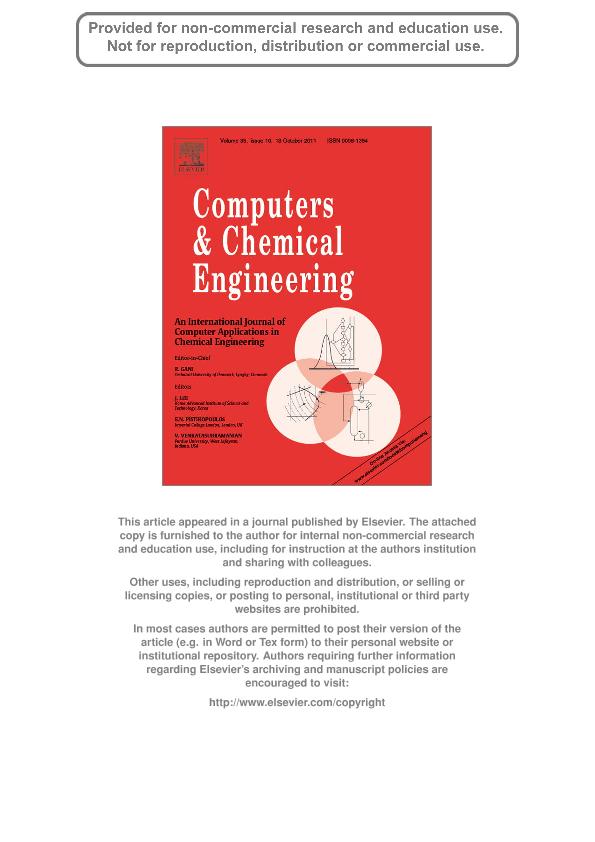Mostrar el registro sencillo del ítem
dc.contributor.author
Molina, Gonzalo Dario

dc.contributor.author
Zumoffen, David Alejandro Ramon

dc.contributor.author
Basualdo, M. S.
dc.date.available
2017-04-11T20:56:31Z
dc.date.issued
2011-10
dc.identifier.citation
Molina, Gonzalo Dario; Zumoffen, David Alejandro Ramon; Basualdo, M. S.; Plant-wide control strategy applied to the Tennessee Eastman process at two operating points; Elsevier; Computers And Chemical Engineering; 35; 10; 10-2011; 2081-2097
dc.identifier.issn
0098-1354
dc.identifier.uri
http://hdl.handle.net/11336/15181
dc.description.abstract
This work presents a new plant-wide control strategy able to be applied on large scale chemical plants. It is based on an extension of the non square relative gain array (NRG) theoretical concepts, introduced by Chang and Yu (1990), and the generalized relative disturbance gain (GRDG) presented in Chang and Yu (1992). The extension of the NRG is useful for searching the best group of controlled variables (CVs) independently of the problem dimensionality. Meanwhile, the extension of the GRDG allows configure the loops pairing by considering the trade-off between servo and regulator behavior. It can be done thanks to define a proper function, named net load effect, accounting both set point and disturbances effects. Even though these concepts are not new, the main contribution of this paper is the selection of the adequate objective function. It is mathematically expressed in a new way, in terms of Frobenius norm of specific matrices related with the models of the plant and very useful for evaluating the process interaction. Then, it drives the search supported by genetic algorithms (GA), which evaluates all the possible combinations of input–output variables. It allows to solve successfully and with less computational effort the combinatorial optimization problem, even though the high dimension usually involved in large scale chemical plants. The use of the relative gain array (RGA) can also be considered for pairing purpose, but in some cases it could drive to a less effective structure. The use of relative normalized gain array (RNGA) for pairing the selected CVs with the most suitable MVs is able to lead to best control structures only if a dynamic model of the plant is available. Therefore, it must be emphasized that this approach is developed for working in cases where only steady-state plant information is available. However, if a dynamic model is disposable too the algorithm is extended to use it. In addition, a mathematical demonstration is presented so as to understand why is possible to find a well conditioned control structure. The methodology is tested in the Tennessee Eastman (TE) process at the base case proposed by Downs and Vogel (1992), and at an optimized working point presented by Ricker (1995). Both working points show two quite different scenarios. Thus, a set of dynamic simulations for both cases and the hardware requirements compared to the previous suggested are given to proof the capacity of this approach.
dc.format
application/pdf
dc.language.iso
eng
dc.publisher
Elsevier

dc.rights
info:eu-repo/semantics/openAccess
dc.rights.uri
https://creativecommons.org/licenses/by-nc-nd/2.5/ar/
dc.subject
Plant-Wide Control
dc.subject
Optimum Energy Sonsumption
dc.subject
Disturbance Rejection
dc.subject
Controllability
dc.subject.classification
Ingeniería de Procesos Químicos

dc.subject.classification
Ingeniería Química

dc.subject.classification
INGENIERÍAS Y TECNOLOGÍAS

dc.subject.classification
Sistemas de Automatización y Control

dc.subject.classification
Ingeniería Eléctrica, Ingeniería Electrónica e Ingeniería de la Información

dc.subject.classification
INGENIERÍAS Y TECNOLOGÍAS

dc.title
Plant-wide control strategy applied to the Tennessee Eastman process at two operating points
dc.type
info:eu-repo/semantics/article
dc.type
info:ar-repo/semantics/artículo
dc.type
info:eu-repo/semantics/publishedVersion
dc.date.updated
2017-04-11T17:42:02Z
dc.journal.volume
35
dc.journal.number
10
dc.journal.pagination
2081-2097
dc.journal.pais
Países Bajos

dc.journal.ciudad
Amsterdam
dc.description.fil
Fil: Molina, Gonzalo Dario. Consejo Nacional de Investigaciones Científicas y Técnicas. Centro Científico Tecnológico Rosario. Centro Internacional Franco Argentino de Ciencias de la Información y Sistemas; Argentina. Universidad Nacional de Rosario. Facultad de Ciencias Exactas, Ingeniería y Agrimensura; Argentina
dc.description.fil
Fil: Zumoffen, David Alejandro Ramon. Consejo Nacional de Investigaciones Científicas y Técnicas. Centro Científico Tecnológico Rosario. Centro Internacional Franco Argentino de Ciencias de la Información y Sistemas; Argentina. Universidad Tecnologica Nacional; Argentina
dc.description.fil
Fil: Basualdo, M. S.. Consejo Nacional de Investigaciones Científicas y Técnicas. Centro Científico Tecnológico Rosario. Centro Internacional Franco Argentino de Ciencias de la Información y Sistemas; Argentina. Universidad Tecnologica Nacional; Argentina
dc.journal.title
Computers And Chemical Engineering

dc.relation.alternativeid
info:eu-repo/semantics/altIdentifier/doi/http://dx.doi.org/10.1016/j.compchemeng.2010.11.006
dc.relation.alternativeid
info:eu-repo/semantics/altIdentifier/url/http://www.sciencedirect.com/science/article/pii/S0098135410003534
Archivos asociados
